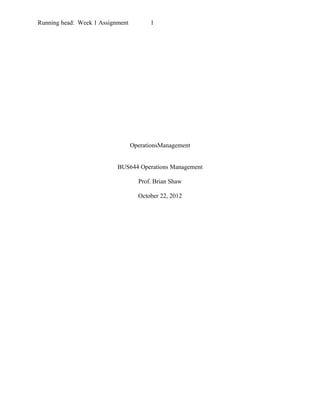
Week 1 644
- 1. Running head: Week 1 Assignment 1 OperationsManagement BUS644 Operations Management Prof. Brian Shaw October 22, 2012
- 2. Week 1 Assignment 2 Cookie production process: The cookie production processing is called batch processing system to produce the dough used to make its cookies. The baking company uses two continuous ovens to bake the cookies. The text states that “Batch processing is used when a moderate value of goods or services is desired, and it can handle a moderate variety of products and services” (Stevenson, 2011, p. 237). After production is scheduled, the first step is the delivery of an order list to the person in charge of mixing who determines the ingredients that are needed to complete the order in order to get the quantity. The computer sends the ingredients automatically to the mixing machines. After mixing, batter is cut into cookie shape and then deposited on a conveyor belt that will take it through the oven for cooking. After cooking, cookies are cooled, and then workers box each cookie by hand, discarding any that do not meet standards. Lastly, a machine wraps, seals and labels boxes, which are then ready to be delivered to distributors and sold in convenience stores and supermarkets. What are two ways that the company has increased productivity? Why did increasing the length of the ovens result in a faster output rate? The book states productivity as “the quantity of goods and services produced each hour of a worker’s time” (2011, p.10). The Baking Company attempts to increased productivity rates in two ways: 1)Is to change the way the cookies are cut. The non-filled cookies could be cut on a diagonal (instead of being round), and if this was done, each cookie required less space, allowing the company to fit more cookies into one batch and 2) A decision to increase the length of each oven by twenty-five (25) feet allows the company to bake more cookies at one time.
- 3. Week 1 Assignment 3 Do you think that the company is making the right decision by not automating the packing of cookies? Explain your reasoning. What obligation does a company have to its employees in a situation such as this? What obligation does it have to the community? Is the size of the town a factor? Would it make a difference if the company was located in a large city? Is the size of the company a factor? What if it was a much larger company? The company is making the right decision by not automating the packing of cookies and having one person do the manual labor. The company is showing its commitment to the community and investing in the employment of the community instead on machinery. The company morals are reflected in the way they do business and individuals who see the company has good intentions to employ and stimulate the economy may also help improve business. The fact that it is a small community proves that the commitment the company has is even bigger and possibly the reason to not automate. If it were a bigger city, I believe the focus would be more on faster production. What factors can cause the company to carry minimal amounts of certain inventories? What benefits result from this policy? Cookies are perishable goods and if not consumed in a short period of time the quality decreases. The biggest factor that causes the company to only carry small amounts of certain inventories is the fact that no additives or preservatives are added to the cookes, which results in the ingredients and the cookies having a relatively short shelf life. Products are ordered based on current orders, and the benefits are the company is not wasteful. As a consumer, what things do you consider in judging the quality of cookies you buy in a supermarket?
- 4. Week 1 Assignment 4 At the supermarket and deciding which cookies to buy for myself and my family, I take only a few factors into consideration. Quality is at the top of the list since most well known brand cookies are relatively the same price. The decision is solely based on what we know to taste fresh which is usually chips a hoy. What advantages and what limitations stem from the company’s not using preservatives in cookies? Advantages include the end product being soft and not too sweet, and also the fact that the cookie is seen by some consumers as a healthier alternative and a closer taste to homemade cookies. Briefly describe the company’s strategy. The Baking Company’s strategy and niche in the market is to produce preservative free, healthy, soft, great taste in quality for the healthy conscious consumers. The company does a great job delivering the product as demanded. Because cookies are made to order using a batch processing system, the company has continued to see high productivity levels while keeping a tight control on inventory levels. Continuing to employ local workers to pack the cookies by hand allows the company to be seen as morally concerned about the well- being of the community and its citizens. The company seems to have a great recipe for a long term success. Reference: Stevenson, W. J. (2011). Operations Management (11th ed.). New York, McGraw Hill Irwin.